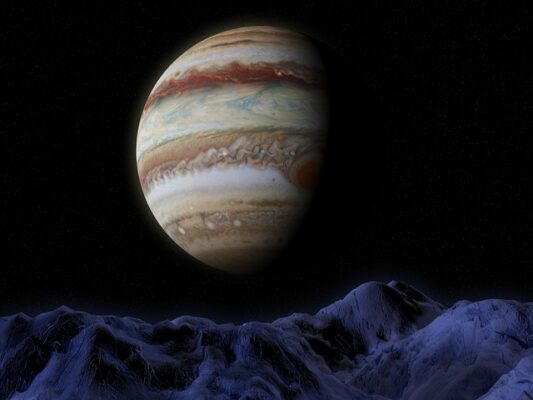Being massive, Jupiter stands as the largest planet in the solar system. It is also the fifth planet from the sun. The planet Jupiter is classified as a Gas Giant together with other similar planets including Neptune, Uranus, and Saturn. These four planets are combined to call Jovian planets. The planet was discovered in the prehistoric times but the discoverer is yet to be known. Jupiter is predominantly composed of hydrogen with some portion of helium. It does not have a real solid surface. Robotic spacecraft has explored the Jupiter on number of occasions. It is believed to be the fastest spinning planet in our solar system in that the planet only takes 10 hours to complete a full rotation on its axis. Be ready for the most amazing Jupiter facts for kids including Jupiter’s mass, atmosphere, temperature, moons, gravity, and characteristics.
Jupiter Facts For Kids
The gigantic Jupiter is believed to give out more energy than it receives from the sun. You might be wondering as to where the extra energy comes from! Actually, Jupiter is capable of generating its own heat that produces from within the planet as a result of gravitational force, which is why you can classify Jupiter as a star. According to scientists, the earthlings should be thankful to Jupiter for its strong gravity seizes several incoming asteroids and comets that would otherwise have crashed into earth. We can say that there would possibly be no life on earth without the planet Jupiter.
- The Jupiter’s clouds are no more than 50 km in thickness.
- One of the most fascinating features of Jupiter is its Great Red Spot which seem to exist for almost 350 years. This spot is deemed to be shrinking.
- Jupiter has planetary rings which are fairly dimmer as compared to that of Saturn’s.
- The planet has the strongest magnetic field among all planets which is why compasses believe to work on Jupiter.
- Jupiter has total 63 moons; all of them are less than 10 km in diameter.
- The spacecraft (from earth) has visited Jupiter 7 times.
- After Venus and Moon, Jupiter is by far the brightest planet in the solar system.
- The Jupiter can hold more than 1,300 earths in it.
- The Voyager I observed at least eight active volcanoes on I0 and plumes spreading up to 250 km above the surface.
Features of Jupiter
- The mass of the Jupiter is 1,898.6 × 1024 kg
- Jupiter has a volume of 143,128 × 1010 km3
- The equatorial radius of a Jupiter is calculated as 71,492 km
- The polar radius of this planet is 66,854 km
- The volumetric mean radius is 69,911 km
- The ellipticity is calculated as 0.06487
- Jupiter has a mean density of 1,326 kg/m3
- It has a gravity of 24.79 m/s2
- The acceleration of Jupiter is 23.12 m/s2
- It has an escape velocity of 59.5 km/s
- The visual magnitude of Jupiter is minus 9.40 V
- There are total 67 satellites
- The black-body temperature of this planet is 110.0 K
 Orbital Parameters of Jupiter
Orbital Parameters of Jupiter
- The semimajor axis of Jupiter is 778.57 × 106
- There are 4,332.589 days in a sidereal orbit period
- There are 4,330.595 days in a sidereal tropical orbit period
- There are 398.88 days in a synodic period
- The maximum orbital velocity is calculated as 13.72 km/s
- The minimum orbital velocity is calculated as 12.44 km/s
- It has a mean orbital velocity of 13.07 km/s
- The orbit eccentricity is 0.0489
- There are 9.9250 hours in a sidereal rotation
- There are 9.9259 hours in a single day
Observational Parameters of Jupiter
- The discoverer of Jupiter is yet to be known; however, it was discovered since prehistoric times
- It has a minimum distance of 588.5 × 106 from the earth
- It has a maximum distance of 968.1 × 106 from the earth
- The maximum apparent diameter of Jupiter from the earth is 50.1 seconds of arc
- The minimum apparent diameter of Jupiter from the earth is 29.8 seconds of arc
Jovian Atmosphere of Jupiter
- The surface temperature of Jupiter is 1000 bars
- The wind speeds is up to 150 m/s
- It has a scale height of 27 km
- The mean molecular weight of this planet is 2.22 g/mole
Leave a Reply